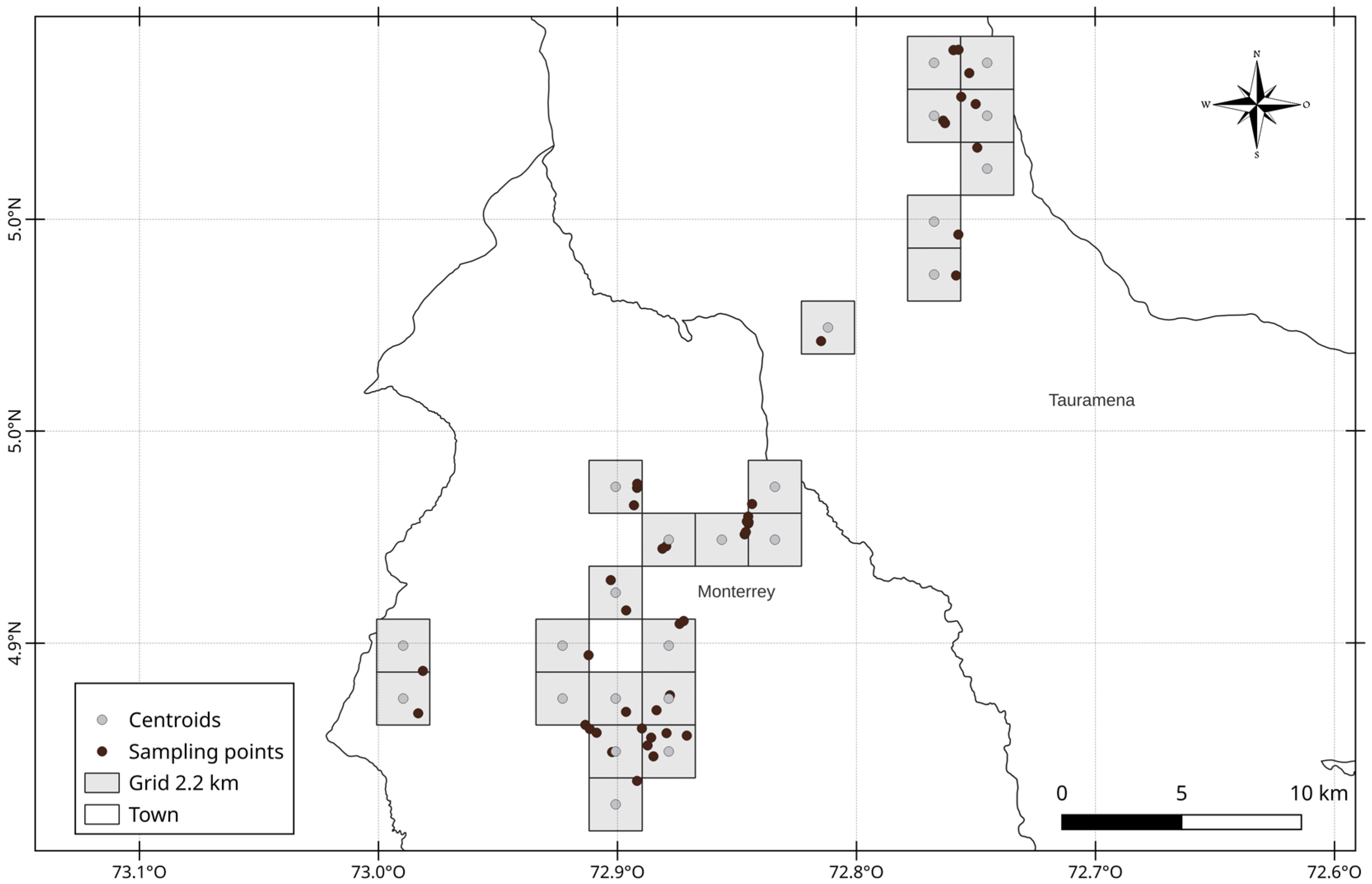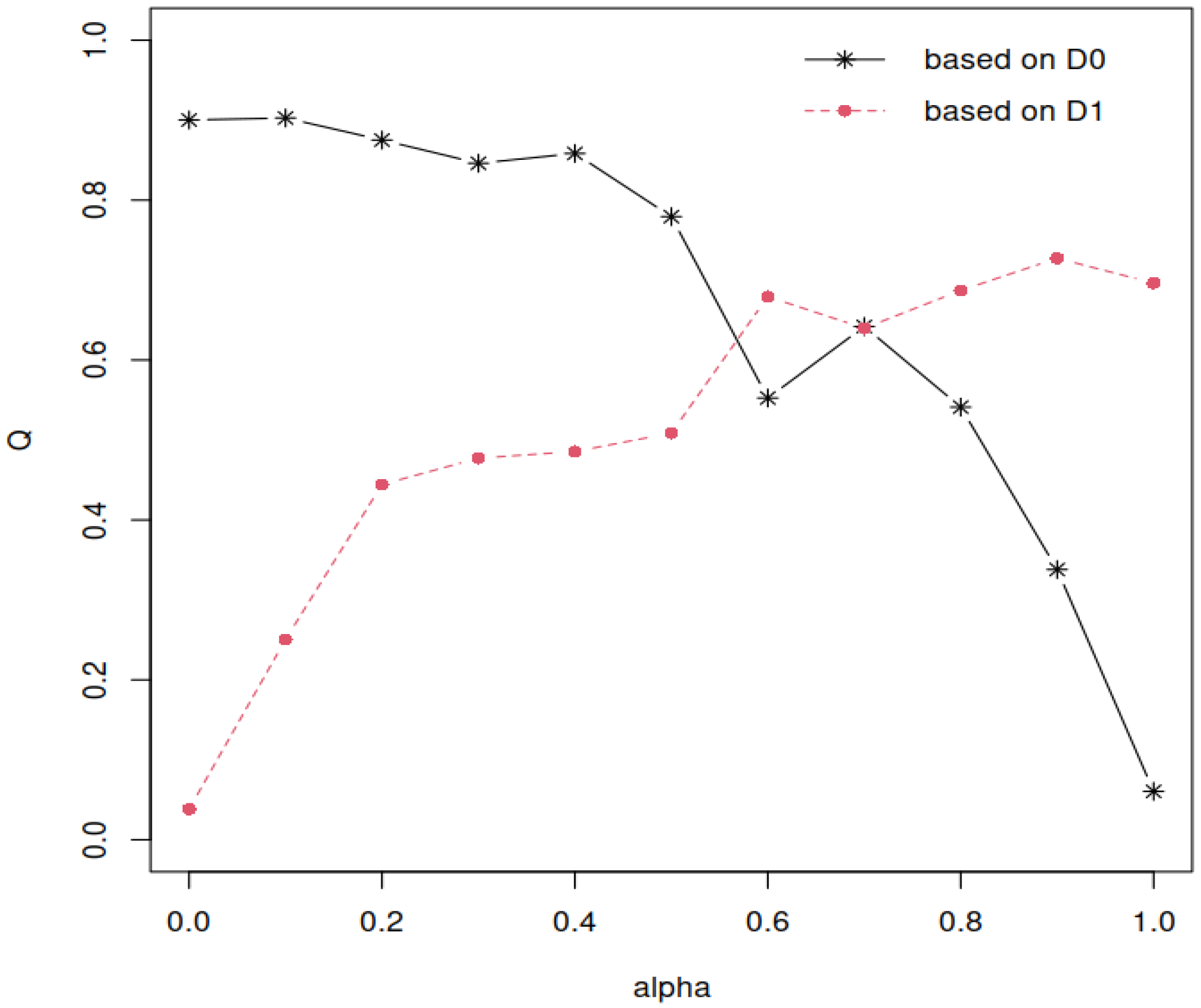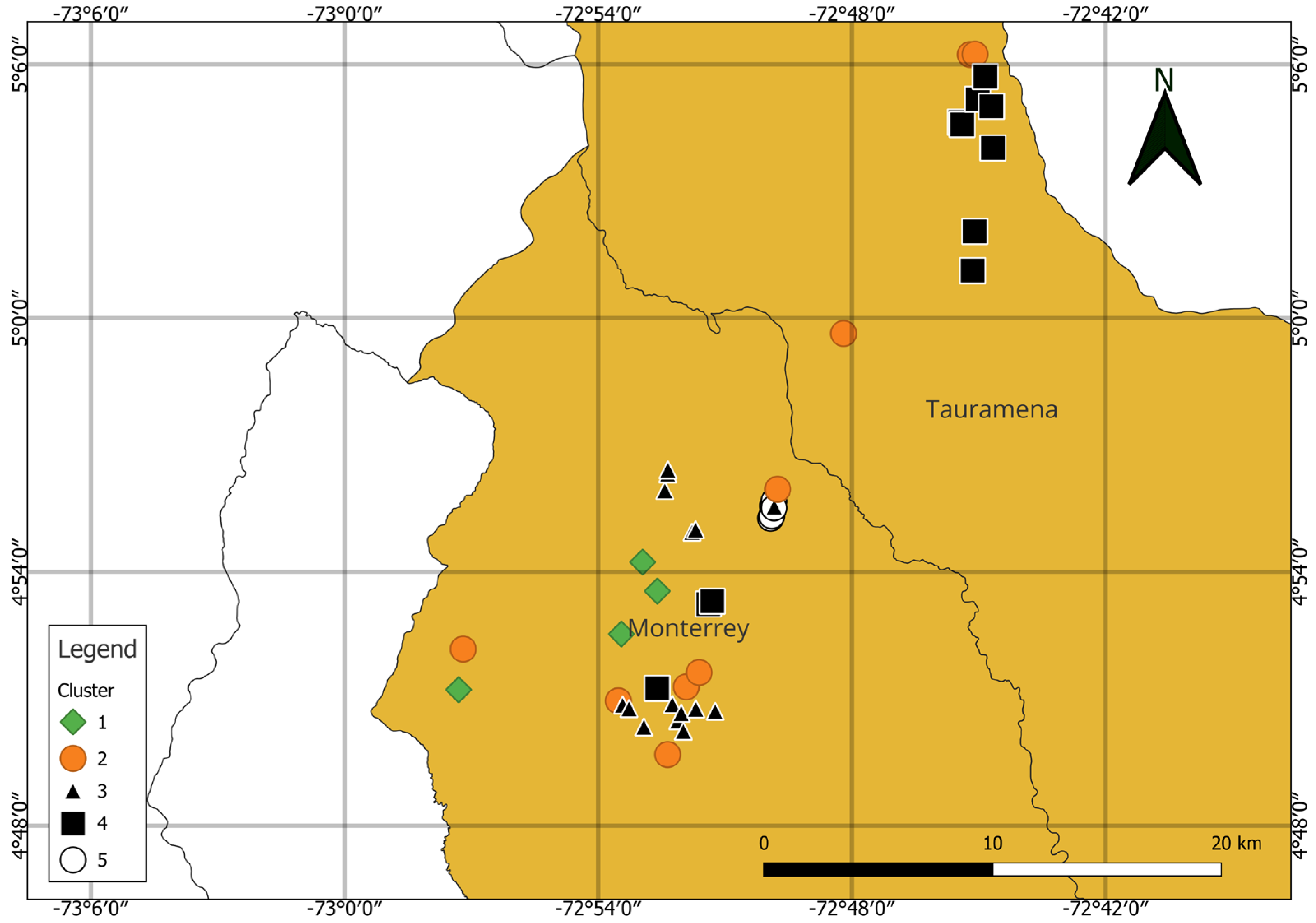Spatial Typology of Lorena Avocado Production Systems in Colombian Lowlands (Casanare): Integrating Agronomic and Socioeconomic Characteristics
Abstract
1. Introduction
- (i)
- What distinct typologies of Lorena avocado production systems exist in the Colombian lowlands of Casanare?
- (ii)
- How do agronomic practices and socioeconomic characteristics vary across different production system typologies?
- (iii)
- What spatial patterns characterize the distribution of avocado production systems in the study region?
2. Materials and Methods
2.1. Study Area and Data Collection
2.2. Data Analysis
3. Results
3.1. Descriptive Characteristics of Production Systems
3.2. Spatial Distribution and Modeling Results
3.3. Geographic Clustering Analysis
3.4. Production System Typologies
3.4.1. Transitional Traditional Systems (N = 15)
3.4.2. Intensive Technical Management Systems (N = 4)
3.4.3. Experience-Based Traditional Systems (N = 5)
3.4.4. Balanced Management Systems (N = 10)
3.4.5. Comprehensive Technical Systems (N = 11)
4. Discussion
4.1. Multiple Pathways to Sustainable Productivity
4.2. Comparative Advantages of Production System Typologies
4.3. Socioeconomic Characteristics and “Hybrid” Farming Systems
4.4. Organic Fertilization and Productivity Trade-Offs
4.5. Spatial Patterns and Targeted Interventions
4.6. Implications for Sustainable Development Policy and Future Research
5. Conclusions
Author Contributions
Funding
Institutional Review Board Statement
Informed Consent Statement
Data Availability Statement
Acknowledgments
Conflicts of Interest
References
- Huber, R.; Finger, R.; Lehmann, A.; Pidgeon, J.; Mann, S. Farm typologies for understanding farm systems and improving agricultural policy. Agric. Syst. 2024, 213, 103800. [Google Scholar] [CrossRef]
- Kansiime, M.K.; van Asten, P.; Sneyers, K. Farm diversity and resource use efficiency: Targeting agricultural policy interventions in East Africa farming systems. NJAS Wagening. J. Life Sci. 2018, 85, 32–41. [Google Scholar] [CrossRef]
- Vos, R.; Bellù, L.G. Global Trends and Challenges to Food and Agriculture into the 21st Century. In Sustainable Food and Agriculture; Elsevier: Amsterdam, The Netherlands, 2019; pp. 11–30. [Google Scholar] [CrossRef]
- Fuglie, K.O. Is agricultural productivity slowing? Glob. Food Sec. 2018, 17, 73–83. [Google Scholar] [CrossRef]
- Pretty, J. Agricultural sustainability: Concepts, principles and evidence. Philos. Trans. R. Soc. B 2008, 363, 447–465. [Google Scholar] [CrossRef]
- Trigo, A.; Marta-Costa, A.; Fragoso, R. Principles of Sustainable Agriculture: Defining Standardized Reference Points. Sustainability 2021, 13, 4086. [Google Scholar] [CrossRef]
- Dönmez, D.; Isak, M.A.; İzgü, T.; Şimşek, Ö. Green Horizons: Navigating the Future of Agriculture through Sustainable Practices. Sustainability 2024, 16, 3505. [Google Scholar] [CrossRef]
- Iakovidis, D.; Gadanakis, Y.; Park, J. Farmer and Adviser Perspectives on Business Planning and Control in Mediterranean Agriculture: Evidence from Argolida, Greece. Agriculture 2023, 13, 450. [Google Scholar] [CrossRef]
- Jiménez, D.; Dorado, H.; Cock, J.; Prager, S.D.; Delerce, S.; Grillon, A.; Rebolledo, M.C.; Van Damme, P. From Observation to Information: Data-Driven Understanding of on Farm Yield Variation. PLoS ONE 2016, 11, e0150015. [Google Scholar] [CrossRef] [PubMed]
- Taramuel-Taramuel, J.P.; Montoya-Restrepo, I.A.; Barrios, D. Drivers linking farmers’ decision-making with farm performance: A systematic review and future research agenda. Heliyon 2023, 9, e20820. [Google Scholar] [CrossRef]
- Zozimo, T.; Kawube, G.; Kalule, S.W. The role of development interventions in enhancing technical efficiency of sunflower producers. J. Agric. Food Res. 2023, 14, 100707. [Google Scholar] [CrossRef]
- Mariano, M.J.; Villano, R.; Fleming, E. Factors influencing farmers’ adoption of modern rice technologies and good management practices in the Philippines. Agric. Syst. 2012, 110, 41–53. [Google Scholar] [CrossRef]
- Moon, W. The lack of dynamic competition and the market insufficiency for agricultural productivity growth: Implications for the role of the state. J. Agric. Appl. Econ. Assoc. 2022, 1, 374–384. [Google Scholar] [CrossRef]
- Taramuel-Taramuel, J.P.; Montoya-Restrepo, I.A.; Barrios, D. Challenges in the avocado production chain in Latin America: A descriptive analysis. Agron. Colomb. 2024, 42, e113982. [Google Scholar] [CrossRef]
- Hass Avocado Board. Colombia A Young, Explosive Industry in Unique Climatic Conditions. Available online: https://www.hassavocadoboard.com (accessed on 18 August 2023).
- Food and Agriculture Organization of the United Nations (FAO). Major Tropical Fruits Market Review; FAO: Rome, Italy, 2023; Available online: https://www.fao.org/3/cc3939en/cc3939en.pdf (accessed on 6 June 2023).
- Madroñero, M.C.; González, J. Avocado Marketing in Colombia. Apunt. Cenes 2023, 42, 273–292. [Google Scholar] [CrossRef]
- Ramírez-Gil, J.G.; Gilchrist Ramelli, E.; Morales Osorio, J.G. Economic impact of the avocado (cv. Hass) wilt disease complex in Antioquia, Colombia, crops under different technological management levels. Crop Prot. 2017, 101, 103–115. [Google Scholar] [CrossRef]
- Taramuel-Taramuel, J.P.; Jiménez-Hernández, C.N.; Barrios, D. Precision agriculture in avocado production: Mapping the landscape of scientific and technological developments. Rev. Colomb. Cienc. Hortic. 2024, 18, 17428. [Google Scholar] [CrossRef]
- Gaitan, S.B.; Ríos, M.D. Socio-economic and technological typology of avocado cv. Hass farms from Antioquia (Colombia). Ciênc. Rural 2020, 50, e20190188. [Google Scholar] [CrossRef]
- Ramírez-Gil, J.G.; López, J.H.; Henao-Rojas, J.C. Causes of Hass avocado fruit rejection in preharvest, harvest, and packing-house: Economic losses and associated variables. Agronomy 2020, 10, 8. [Google Scholar] [CrossRef]
- Biazin, B.; Sterk, G.; Temesgen, M.; Abdulkedir, A.; Stroosnijder, L. Smallholders’ avocado production systems and tree productivity in the southern highlands of Ethiopia. Agrofor. Syst. 2018, 92, 127–137. [Google Scholar] [CrossRef]
- Mwangi, M.; Kariuki, S. Factors Determining Adoption of New Agricultural Technology by Smallholder Farmers in Developing Countries. J. Econ. Sustain. Dev. 2015, 6, 208–216. Available online: https://core.ac.uk/download/pdf/234646919.pdf (accessed on 30 January 2025).
- Zhang, H.; Chen, Z.; Wang, J.; Wang, H.; Zhang, Y. Spatial-Temporal Pattern of Agricultural Total Factor Productivity Change (Tfpch) in China and Its Implications for Agricultural Sustainable Development. Agriculture 2023, 13, 718. [Google Scholar] [CrossRef]
- Notaro, M.; Palai, G.; Premand, M.; Schaller, N.; Saj, S.; Grislain, Q.; Koko, L.; Tixier, P. The spatial distribution and height of associated crops influence cocoa tree productivity in complex agroforestry systems. Agron. Sustain. Dev. 2021, 41, 60. [Google Scholar] [CrossRef]
- Sekiya, N.; Konaté, M.; Silué, S.; Traoré, O.; Konaté, S.; Séré, Y.; Rakotomalala, M. Agronomic practices preventing local outbreaks of rice yellow mottle virus disease revealed by spatial autoregressive analysis. Agron. Sustain. Dev. 2022, 42, 15. [Google Scholar] [CrossRef]
- Sseruwagi, P.; Lehmann, E.; Sigombe, P.; Ddamulira, G.; Van Casteren, J.W.; De Bauw, P. Characterizing avocado production systems for Ugandan exports: The need for consolidation and support for sustainable development. Front. Sustain. Food Syst. 2025, 9, 1500012. [Google Scholar] [CrossRef]
- Álvarez, G.E.G.; Gutiérrez, A.M.L.; Valencia, K.Á.; Mossos, P.S.; Rozo, D.L.S.; Hurtado, N.C. Genetic and chemical characterization of avocado commercial cultivars avocado of Risaralda Colombia. Rev. Bras. Frutic. 2020, 42, e-593. [Google Scholar] [CrossRef]
- Unidad de Planificación Rural Agropecuaria (UPRA). Evaluaciones Agropecuarias Municipales (EVA) 2024; UPRA: Bogotá, Colombia, 2024. Available online: https://upra.gov.co/es-co/Paginas/eva.aspx (accessed on 23 March 2025).
- Benedetti, R.; Piersimoni, F.; Postiglione, P. Sampling Spatial Units for Agricultural Surveys; Advances in Spatial Science; Springer: Berlin/Heidelberg, Germany, 2015. [Google Scholar] [CrossRef]
- Elhorst, J.P. Spatial Econometrics: From Cross-Sectional Data to Spatial Panels; Springer Briefs in Regional Science; Springer: Berlin/Heidelberg, Germany, 2014. [Google Scholar] [CrossRef]
- Bivand, R. R Packages for Analyzing Spatial Data: A Comparative Case Study with Areal Data. Geogr. Anal. 2022, 54, 488–518. [Google Scholar] [CrossRef]
- Chavent, M.; Kuentz-Simonet, V.; Labenne, A.; Saracco, J. ClustGeo: An R package for hierarchical clustering with spatial constraints. Comput. Stat. 2018, 33, 1799–1822. [Google Scholar] [CrossRef]
- Alvarez, S.; Paas, W.; Descheemaeker, K.; Tittonell, P.; Groot, J.C.J. Capturing farm diversity with hypothesis-based typologies: An innovative methodological framework for farming system typology development. PLoS ONE 2018, 13, e0194757. [Google Scholar] [CrossRef]
- Anacona, Y.E.; Solis, A.F.; Rubiano-Ovalle, O.; Paz, H.; Ramirez, I. Spatial Analysis of the Suitability of Hass Avocado Cultivation in the Cauca Department, Colombia, Using Multi-Criteria Decision Analysis and Geographic Information Systems. ISPRS Int. J. Geo-Inf. 2023, 12, 136. [Google Scholar] [CrossRef]
- Bergh, B.O. The origin, nature, and genetic improvement of the avocado. Calif. Avocado Soc. Yearb. 1992, 76, 61–75. [Google Scholar]
- Holzapfel, E.; de Souza, J.A.; Jara, J.; Guerra, H.C. Responses of avocado production to variation in irrigation levels. Irrig. Sci. 2017, 35, 205–215. [Google Scholar] [CrossRef]
- Selladurai, R.; Awachare, C.M. Nutrient management for avocado (Persea americana miller). J. Plant Nutr. 2020, 43, 138–147. [Google Scholar] [CrossRef]
- Menzel, C.M.; Le Lagadec, M.D. Increasing the productivity of avocado orchards using high-density plantings: A review. Sci. Hortic. 2014, 177, 21–36. [Google Scholar] [CrossRef]
- Dymond, K.; Celis-Diez, J.L.; Potts, S.G.; Howlett, B.G.; Willcox, B.K.; Garratt, M.P.D. The role of insect pollinators in avocado production: A global review. J. Appl. Entomol. 2021, 145, 369–383. [Google Scholar] [CrossRef]
- Rada, N.E.; Fuglie, K.O. New perspectives on farm size and productivity. Food Policy 2019, 84, 147–152. [Google Scholar] [CrossRef]
- Cáceres-Zambrano, J.; Ramírez-Gil, J.G.; Barrios, D. Validating Technologies and Evaluating the Technological Level in Avocado Production Systems: A Value Chain Approach. Agronomy 2022, 12, 3130. [Google Scholar] [CrossRef]
- Johansson, E.; Nilsson, P.; Hansson, H. Transition dynamics of hybrid farmers: A survival analysis of exits and entries into full-time farming. Eur. Rev. Agric. Econ. 2024, 51, 1384–1409. [Google Scholar] [CrossRef]
- Ramirez-Gómez, C.J.; Rodríguez, H.; Restrepo-Betancur, F. Farmer, learning and teaching: A cluster analysis of technology adopters in avocado farming in Colombia. Trop. Subtrop. Agroecosyst. 2023, 26, 4434. [Google Scholar] [CrossRef]
- Knapp, S.; van der Heijden, M.G.A. A global meta-analysis of yield stability in organic and conservation agriculture. Nat. Commun. 2018, 9, 3632. [Google Scholar] [CrossRef] [PubMed]
- Seufert, V.; Ramankutty, N.; Foley, J.A. Comparing the yields of organic and conventional agriculture. Nature 2012, 485, 229–232. [Google Scholar] [CrossRef]
- Reganold, J.P.; Wachter, J.M. Organic agriculture in the twenty-first century. Nat. Plants 2016, 2, 15221. [Google Scholar] [CrossRef] [PubMed]
- Xu, X.; Zeng, Z.; Li, J.; Zhang, L.; Chen, Y.; Li, P.; Wang, L.; Liu, M. Optimizing organic fertilization towards sustainable vegetable production evaluated by long-term field measurement and multi-level fuzzy comprehensive model. Agric. Ecosyst. Environ. 2024, 368, 109008. [Google Scholar] [CrossRef]
- Schmidtner, E.; Lippert, C.; Engler, B.; Häring, A.M.; Aurbacher, J.; Dabbert, S. Spatial distribution of organic farming in Germany: Does neighbourhood matter? Eur. Rev. Agric. Econ. 2012, 39, 661–683. [Google Scholar] [CrossRef]
- Ward, P.S.; Pede, V.O. Capturing social network effects in technology adoption: The spatial diffusion of hybrid rice in Bangladesh. Aust. J. Agric. Resour. Econ. 2015, 59, 225–241. [Google Scholar] [CrossRef]




| Category and Variables | Description | Value |
|---|---|---|
| Production characteristics | Mean ± SD | |
| Yield 1 | Annual production (kg) | 2908.89 ± 1849.67 |
| Number of trees 1 | Trees per farm | 321.69 ± 331.00 |
| Tree yield 1 | Production per tree (kg tree−1) | 17.46 ± 7.22 |
| Planting distance 1 | Distance between trees (m) | 6.65 ± 1.17 |
| Plot age 2 | % Distribution | |
| Initial production (≤5 years) | Farms in early production phase | 24.44 |
| Mature production (>5 years) | Farms in production plateau | 75.56 |
| Agricultural practices 3 | % Adoption | |
| Irrigation | Use of irrigation systems | 80.00 |
| Soil analysis | Soil testing practice | 73.33 |
| Foliar analysis | Leaf testing practice | 17.78 |
| Chemical fertilization | Use of chemical fertilizers | 73.33 |
| Organic fertilization | Use of organic fertilizers | 93.33 |
| Edaphic fertilization | Soil-applied fertilizers | 82.22 |
| Liming | Soil pH management | 91.11 |
| Pest control | Pest management practices | 97.78 |
| Monitoring | Crop monitoring practices | 91.11 |
| Weed control | Weed management practices | 97.78 |
| Pruning | Tree pruning practices | 91.11 |
| Tool disinfection | Sanitization of tools | 84.44 |
| Pruning cut disinfection | Treatment of pruning wounds | 84.44 |
| Socioeconomic characteristics | ||
| Age 1 | Farmer’s age (years) | 53.98 ± 11.30 |
| Education level 2 | % Distribution | |
| Primary | Up to grade 5 | 33.33 |
| Secondary | Grades 6–11 | 26.67 |
| Undergraduate | Technical/university education | 35.56 |
| Graduate | Post-graduate education | 4.44 |
| Cooperative membership 4 | Belonging to cooperatives | 31.11 |
| Direct sales 4 | Direct market access | 80.00 |
| Additional income 4 | Other income sources | 91.11 |
| Hired labor 4 | Use of external labor | 95.56 |
| Technical assistance 4 | Access to technical support | 64.00 |
| Expansion plans 4 | Plans to expand production | 35.56 |
| Coefficients | Estimate | Std. Error | Statistic(.) 1 | Pr(>|.|) 2 |
|---|---|---|---|---|
| Intercept | 13.4080 | 2.6466 | z = 5.0663 | 4.06 × 10−7 |
| Lambda | 0.6022 | 0.1468 | LR = 10.3720 | 0.0013 |
| Residual Variance | Moran I-Test | Shapiro-Test |
|---|---|---|
| 26.601 | p = 0.2694 | p = 0.9451 |
| Characteristic | Transitional Traditional (n = 15) | Intensive Technical Management (n = 4) | Experience-Based Traditional (n = 5) | Balanced Management (n = 10) | Comprehensive Technical (n = 11) |
|---|---|---|---|---|---|
| Scale and production | |||||
| Average trees per farm | 187.93 | 162.50 | 183.40 | 299.60 | 644.91 |
| Average yield (kg) | 2686.67 | 3375 | 3280 | 2870 | 2909.09 |
| Mature orchards (>5 y) | 86.67% | 75% | 100% | 70% | 54.55% |
| Technical/management aspects | |||||
| Technological adoption | Moderate | High | Low | Balanced | Very high |
| Irrigation | 73.33% | 75% | 40% | 90% | 100% |
| Soil analysis | 66.67% | 100% | 40% | 80% | 81.82% |
| Socioeconomic | |||||
| Average farmer’s age (years) | 52.47 | 50.00 | 58.40 | 55.90 | 53.73 |
| Predominant education | Mixed higher | Polarized | Primary | Mixed | Higher education |
| Technical assistance | 73.33% | 25% | 60% | 60% | 72.73% |
| Cooperative membership | 53.33% | 25% | 0% | 20% | 27.27% |
| Expansion plans | 26.67% | 50% | 60% | 10% | 54.55% |
Disclaimer/Publisher’s Note: The statements, opinions and data contained in all publications are solely those of the individual author(s) and contributor(s) and not of MDPI and/or the editor(s). MDPI and/or the editor(s) disclaim responsibility for any injury to people or property resulting from any ideas, methods, instructions or products referred to in the content. |
© 2025 by the authors. Licensee MDPI, Basel, Switzerland. This article is an open access article distributed under the terms and conditions of the Creative Commons Attribution (CC BY) license (https://creativecommons.org/licenses/by/4.0/).
Share and Cite
Taramuel-Taramuel, J.P.; Montoya-Restrepo, I.A.; Darghan Contreras, A.E.; Miranda Lasprilla, D.; Barrios, D. Spatial Typology of Lorena Avocado Production Systems in Colombian Lowlands (Casanare): Integrating Agronomic and Socioeconomic Characteristics. Sustainability 2025, 17, 8461. https://doi.org/10.3390/su17188461
Taramuel-Taramuel JP, Montoya-Restrepo IA, Darghan Contreras AE, Miranda Lasprilla D, Barrios D. Spatial Typology of Lorena Avocado Production Systems in Colombian Lowlands (Casanare): Integrating Agronomic and Socioeconomic Characteristics. Sustainability. 2025; 17(18):8461. https://doi.org/10.3390/su17188461
Chicago/Turabian StyleTaramuel-Taramuel, Juan P., Iván A. Montoya-Restrepo, Aquiles Enrique Darghan Contreras, Diego Miranda Lasprilla, and Dursun Barrios. 2025. "Spatial Typology of Lorena Avocado Production Systems in Colombian Lowlands (Casanare): Integrating Agronomic and Socioeconomic Characteristics" Sustainability 17, no. 18: 8461. https://doi.org/10.3390/su17188461
APA StyleTaramuel-Taramuel, J. P., Montoya-Restrepo, I. A., Darghan Contreras, A. E., Miranda Lasprilla, D., & Barrios, D. (2025). Spatial Typology of Lorena Avocado Production Systems in Colombian Lowlands (Casanare): Integrating Agronomic and Socioeconomic Characteristics. Sustainability, 17(18), 8461. https://doi.org/10.3390/su17188461








